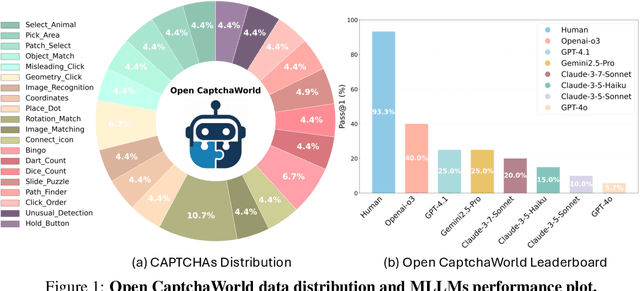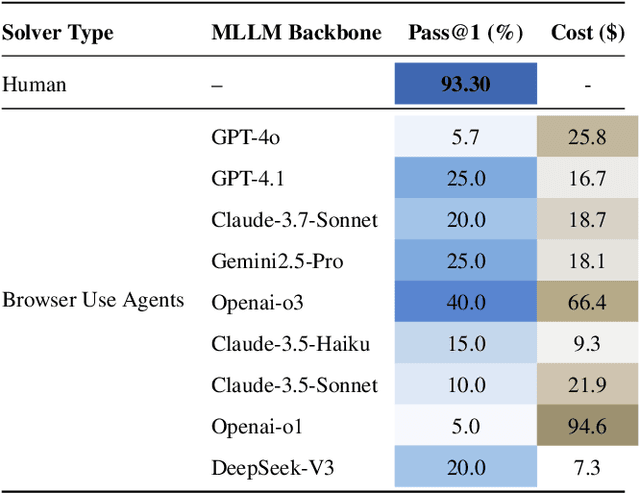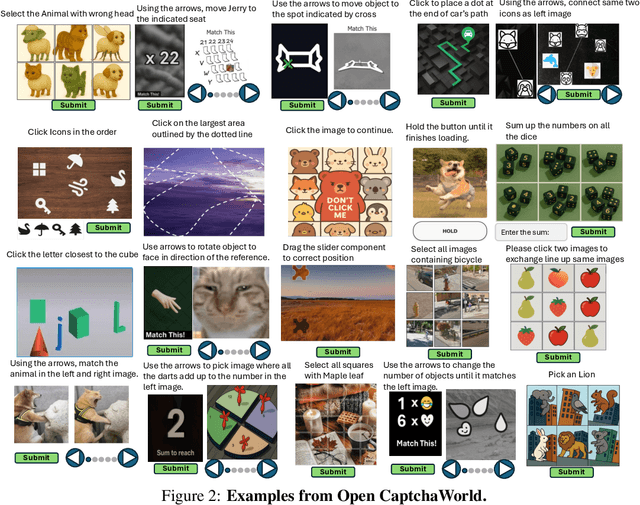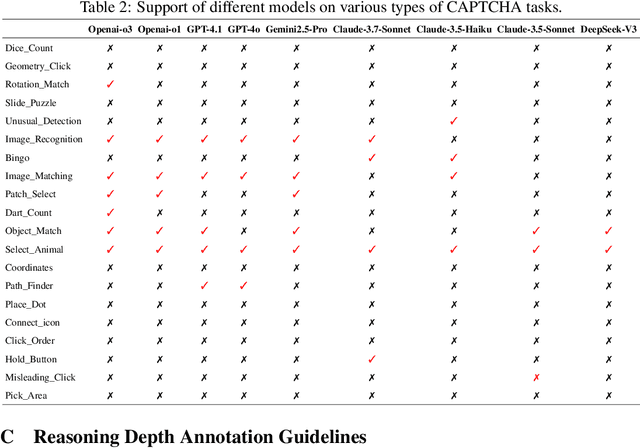Xiaohan Zhao
Open CaptchaWorld: A Comprehensive Web-based Platform for Testing and Benchmarking Multimodal LLM Agents
May 30, 2025



Abstract:CAPTCHAs have been a critical bottleneck for deploying web agents in real-world applications, often blocking them from completing end-to-end automation tasks. While modern multimodal LLM agents have demonstrated impressive performance in static perception tasks, their ability to handle interactive, multi-step reasoning challenges like CAPTCHAs is largely untested. To address this gap, we introduce Open CaptchaWorld, the first web-based benchmark and platform specifically designed to evaluate the visual reasoning and interaction capabilities of MLLM-powered agents through diverse and dynamic CAPTCHA puzzles. Our benchmark spans 20 modern CAPTCHA types, totaling 225 CAPTCHAs, annotated with a new metric we propose: CAPTCHA Reasoning Depth, which quantifies the number of cognitive and motor steps required to solve each puzzle. Experimental results show that humans consistently achieve near-perfect scores, state-of-the-art MLLM agents struggle significantly, with success rates at most 40.0% by Browser-Use Openai-o3, far below human-level performance, 93.3%. This highlights Open CaptchaWorld as a vital benchmark for diagnosing the limits of current multimodal agents and guiding the development of more robust multimodal reasoning systems. Code and Data are available at this https URL.
A Frustratingly Simple Yet Highly Effective Attack Baseline: Over 90% Success Rate Against the Strong Black-box Models of GPT-4.5/4o/o1
Mar 13, 2025Abstract:Despite promising performance on open-source large vision-language models (LVLMs), transfer-based targeted attacks often fail against black-box commercial LVLMs. Analyzing failed adversarial perturbations reveals that the learned perturbations typically originate from a uniform distribution and lack clear semantic details, resulting in unintended responses. This critical absence of semantic information leads commercial LVLMs to either ignore the perturbation entirely or misinterpret its embedded semantics, thereby causing the attack to fail. To overcome these issues, we notice that identifying core semantic objects is a key objective for models trained with various datasets and methodologies. This insight motivates our approach that refines semantic clarity by encoding explicit semantic details within local regions, thus ensuring interoperability and capturing finer-grained features, and by concentrating modifications on semantically rich areas rather than applying them uniformly. To achieve this, we propose a simple yet highly effective solution: at each optimization step, the adversarial image is cropped randomly by a controlled aspect ratio and scale, resized, and then aligned with the target image in the embedding space. Experimental results confirm our hypothesis. Our adversarial examples crafted with local-aggregated perturbations focused on crucial regions exhibit surprisingly good transferability to commercial LVLMs, including GPT-4.5, GPT-4o, Gemini-2.0-flash, Claude-3.5-sonnet, Claude-3.7-sonnet, and even reasoning models like o1, Claude-3.7-thinking and Gemini-2.0-flash-thinking. Our approach achieves success rates exceeding 90% on GPT-4.5, 4o, and o1, significantly outperforming all prior state-of-the-art attack methods. Our optimized adversarial examples under different configurations and training code are available at https://github.com/VILA-Lab/M-Attack.
More than Correlation: Do Large Language Models Learn Causal Representations of Space?
Dec 26, 2023Abstract:Recent work found high mutual information between the learned representations of large language models (LLMs) and the geospatial property of its input, hinting an emergent internal model of space. However, whether this internal space model has any causal effects on the LLMs' behaviors was not answered by that work, led to criticism of these findings as mere statistical correlation. Our study focused on uncovering the causality of the spatial representations in LLMs. In particular, we discovered the potential spatial representations in DeBERTa, GPT-Neo using representational similarity analysis and linear and non-linear probing. Our casual intervention experiments showed that the spatial representations influenced the model's performance on next word prediction and a downstream task that relies on geospatial information. Our experiments suggested that the LLMs learn and use an internal model of space in solving geospatial related tasks.
Feature Correlation-guided Knowledge Transfer for Federated Self-supervised Learning
Nov 14, 2022Abstract:To eliminate the requirement of fully-labeled data for supervised model training in traditional Federated Learning (FL), extensive attention has been paid to the application of Self-supervised Learning (SSL) approaches on FL to tackle the label scarcity problem. Previous works on Federated SSL generally fall into two categories: parameter-based model aggregation (i.e., FedAvg, applicable to homogeneous cases) or data-based feature sharing (i.e., knowledge distillation, applicable to heterogeneous cases) to achieve knowledge transfer among multiple unlabeled clients. Despite the progress, all of them inevitably rely on some assumptions, such as homogeneous models or the existence of an additional public dataset, which hinder the universality of the training frameworks for more general scenarios. Therefore, in this paper, we propose a novel and general method named Federated Self-supervised Learning with Feature-correlation based Aggregation (FedFoA) to tackle the above limitations in a communication-efficient and privacy-preserving manner. Our insight is to utilize feature correlation to align the feature mappings and calibrate the local model updates across clients during their local training process. More specifically, we design a factorization-based method to extract the cross-feature relation matrix from the local representations. Then, the relation matrix can be regarded as a carrier of semantic information to perform the aggregation phase. We prove that FedFoA is a model-agnostic training framework and can be easily compatible with state-of-the-art unsupervised FL methods. Extensive empirical experiments demonstrate that our proposed approach outperforms the state-of-the-art methods by a significant margin.
GAGA: Deciphering Age-path of Generalized Self-paced Regularizer
Sep 23, 2022



Abstract:Nowadays self-paced learning (SPL) is an important machine learning paradigm that mimics the cognitive process of humans and animals. The SPL regime involves a self-paced regularizer and a gradually increasing age parameter, which plays a key role in SPL but where to optimally terminate this process is still non-trivial to determine. A natural idea is to compute the solution path w.r.t. age parameter (i.e., age-path). However, current age-path algorithms are either limited to the simplest regularizer, or lack solid theoretical understanding as well as computational efficiency. To address this challenge, we propose a novel \underline{G}eneralized \underline{Ag}e-path \underline{A}lgorithm (GAGA) for SPL with various self-paced regularizers based on ordinary differential equations (ODEs) and sets control, which can learn the entire solution spectrum w.r.t. a range of age parameters. To the best of our knowledge, GAGA is the first exact path-following algorithm tackling the age-path for general self-paced regularizer. Finally the algorithmic steps of classic SVM and Lasso are described in detail. We demonstrate the performance of GAGA on real-world datasets, and find considerable speedup between our algorithm and competing baselines.
 Add to Chrome
Add to Chrome Add to Firefox
Add to Firefox Add to Edge
Add to Edge